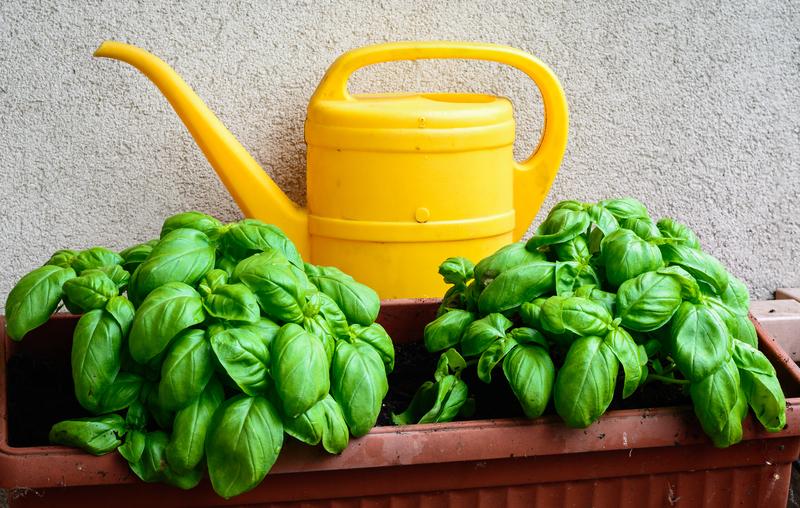Harnessing Garden Innovations to Combat Climate Change
Posted on 04/06/2025
Harnessing Garden Innovations to Combat Climate Change
As the climate crisis intensifies, forward-thinking gardeners and land stewards are turning their green spaces into powerful tools for climate action. But what does it truly mean to harness garden innovations to combat climate change? This article delves deeply into transformative gardening methods, revolutionary technologies, and planet-positive practices that anyone can adopt to create resilient, sustainable, and climate-friendly gardens. Discover how your backyard, balcony, or community plot can become part of the solution.

Understanding the Role of Gardens in Climate Change Mitigation
In the face of escalating global warming, gardens might seem like small players. However, their potential impact is enormous. Gardens--whether urban, rural, private, or communal--can act as microcosms for broader environmental change. By embracing modern garden innovations and regenerative practices, gardeners are uniquely positioned to:
- Store atmospheric carbon (carbon sequestration) in soil and plants
- Reduce greenhouse gas emissions through decreased reliance on synthetic fertilizers and fossil fuels
- Improve biodiversity and create wildlife corridors
- Cool urban environments and buffer against heatwaves
- Increase resilience to climate extremes like droughts and flooding
By integrating innovative gardening ideas to fight climate change, everyone can play a part in restoring ecological balance and ensuring food and environmental security for future generations.
The Power of Regenerative Gardening for Climate Action
What is Regenerative Gardening?
Regenerative gardening is a holistic approach that prioritizes soil health, plant diversity, and ecosystem restoration. Unlike traditional gardening, which often relies heavily on synthetic inputs and can degrade soil over time, regenerative practices use nature-based solutions to build resilience, increase productivity, and actively draw down atmospheric carbon--a crucial strategy to mitigate global warming.
Key Regenerative Innovations in Climate-Smart Gardening
- No-dig or low-till gardening: Minimizes soil disturbance, boosts carbon sequestration, and protects beneficial microbes.
- Composting advancements: Utilizing hot compost systems, worm bins, and bokashi fermentation to recycle organic waste and feed the soil.
- Cover cropping: Planting non-harvested crops in off-seasons to fix nitrogen, shelter soil, and draw down CO2.
- Biochar: Incorporating carbon-rich, charcoal-like material to permanently lock carbon in the ground while improving soil fertility.
Case Study: Urban Permaculture Gardens
Permaculture gardens in urban environments, like food forests in city parks, use a mix of trees, shrubs, perennials, and annuals to mimic natural ecosystems. These gardens enhance biodiversity, store water, and sequester carbon--all while yielding food and habitat. Home gardeners can replicate these strategies on any scale, making it an accessible garden innovation for climate resilience.
Smart Technology Transforming Climate-Resilient Gardens
Water Efficiency and Drought Solutions
With rising temperatures and water scarcity on the rise due to climate change, water-wise innovations are crucial:
- Smart irrigation systems: Automated watering using moisture sensors and weather data optimizes water use, reducing waste.
- Rainwater harvesting innovations: Modern tanks, permeable paving, and rain gardens capture, store, and slowly release water to nourish plants.
- Drip irrigation advances: Deliver water right to plant roots with minimal evaporation and runoff.
Using Data and AI in the Garden
- Soil sensors and monitoring devices: New gadgets help gardeners analyze soil moisture, pH, and nutrient levels, tailoring inputs to reduce excess fertilizer use--a key step for climate-conserving garden practices.
- Plant identification apps: Artificial intelligence identifies pests, diseases, and invasive species, supporting early intervention and reducing the need for pesticides.
- Garden planning software: Simulate designs for climate-adaptive gardens, optimizing plant placement for sun, shade, and local microclimates.
Plant Selection: The Climate-Conscious Approach
Drought-Tolerant and Native Plant Scaping
Selecting the right plants is one of the most effective garden innovations for climate change. Native and drought-resilient species have evolved to thrive in local conditions, requiring less water, fertilizer, and pest management.
- Choose deep-rooted perennials that stabilize soil and store more carbon.
- Plant pollinator-friendly natives that support bees, butterflies, and birds.
- Create layered plantings (trees, shrubs, understorey plants) to maximize biodiversity and carbon drawdown.
Edible Gardens: Localizing Food Production
Growing your own vegetables, fruits, and herbs--whether in raised beds, containers, or vertical gardens--dramatically reduces "food miles" and reliance on industrial agriculture, which accounts for a significant portion of global greenhouse gas emissions. Locally grown produce also offers fresher, healthier, and more resilient food sources as climate patterns shift.
Soil Health: The Heart of Carbon Sequestration
Innovative Soil Practices
- Mulching breakthroughs: Using organic and biodegradable mulches insulates the soil, reduces evaporation, and suppresses weeds, all while building organic matter.
- Dynamic compost amendments: Adding diverse amendments--leaf mold, biochar, aged manure--optimizes microbial activity for maximum carbon retention.
- Fungi-powered solutions: Mycorrhizal inoculants forge beneficial plant-fungi partnerships, enhancing nutrient uptake and increasing carbon storage.
Peat-Free Gardening
Traditional peat-based composts are a major contributor to habitat loss and carbon release. Today's climate-wise gardeners minimize or eliminate peat, choosing innovative alternatives like coconut coir, leaf mold, and locally sourced compost. Using these options helps preserve peat bogs--vital global carbon sinks.
Innovative Garden Design for Climate Resilience
Microclimate Creation and Energy Efficiency
Strategically designed gardens can buffer homes and urban streets against climate extremes:
- Green roofs and living walls: Insulate buildings, lower urban heat, and filter pollution--all while growing food or flowers.
- Treed windbreaks and hedges: Reduce wind speed, conserve water, and shelter wildlife.
- Paved surface alternatives: Replace concrete with permeable paving, gravel, or no-mow ground covers to increase water infiltration and cool the ground.
Community Gardens as Climate Solutions
Shared gardens leverage collective action and resources to create larger, more impactful green spaces. Many cities now support edible landscape initiatives, stormwater gardens, and carbon-positive parks--demonstrating how urban gardening innovation to fight climate change can be both practical and scalable.
Reducing Inputs: Tools, Fertilizers, and Pesticides
Low-Carbon Garden Tools & Practices
- Manual and electric tools: Replace fossil-fuel-powered mowers and trimmers with battery-powered, solar, or classic hand tools to cut emissions.
- DIY garden hacks: Repurpose household items and reclaimed materials for beds, trellises, or compost bins, supporting a circular economy and reducing waste.
Eco-friendly Fertilizers and Pest Management
Sustainable gardening pivots away from chemically-intensive inputs. Use natural amendments--like compost tea, worm casts, and seaweed emulsions--to feed plants and soil without polluting waterways or emitting nitrous oxide. Integrated pest management (IPM), companion planting, and biological controls lower the need for synthetic pesticides, promoting climate-friendly gardening.
Biodiversity Gardens: Boosting Nature-Based Solutions
Rewilding and Habitat Gardens
- Wildflower meadows: Support pollinators, store carbon, and require fewer inputs than lawns.
- Habitat corridors: Connect fragmented environments to foster species migration and genetic diversity.
- Water features and mini-ponds: Attract amphibians and insects, increasing overall garden resilience against pests and drought.
Education and Community Engagement for Climate Gardening
Spreading Awareness
The potential for gardens--large and small--to serve as climate champions grows exponentially with community involvement. Workshops, social media, and demonstration gardens spread key messages about the benefits of innovative gardening solutions to climate change and give more people the chance to contribute locally driven environmental action.
Policy and Incentives
Local governments, nonprofits, and institutions are increasingly recognizing the role urban and suburban gardens play in climate policy--offering funding for rain barrels, tree planting, and native garden conversions. Stay informed about programs in your area and advocate for expanded support of climate-smart gardening.
Measuring the Impact of Garden Innovations on Climate Change
How do we quantify garden climate benefits? While it may be difficult to measure carbon storage or emission reductions precisely in a small plot, emerging tools and citizen science initiatives provide helpful estimates. Apps and calculators track the carbon footprint of your gardening practices, helping you assess the progress of your climate-smart choices over time.

Top Tips for Creating a Climate-Friendly Garden
- Build healthy living soil with regular additions of compost, mulch, and biochar.
- Choose diverse, climate-appropriate plants, prioritizing native and drought-resistant varieties.
- Adopt water conservation strategies such as mulching, rainwater harvesting, and efficient irrigation.
- Switch to electric or manual tools to cut fossil fuel use.
- Reduce, reuse, recycle materials in all aspects of garden design and maintenance.
- Encourage wildlife and pollinators to increase ecosystem stability.
The Future of Gardening in a Changing Climate
As we move deeper into the era of climate change, garden innovations will become ever more vital. The combination of ancient practices (no-dig, composting, native planting) with cutting-edge technology (smart sensors, AI-driven apps, water-saving devices) offers real hope for reversing environmental degradation.
Imagine a world filled with gardens designed not just for beauty and yield, but for resilience, resource conservation, and carbon drawdown. Whether you are a novice or master gardener, farm owner, or balcony enthusiast, your space has the power to support a stable climate--and inspire neighbors to do the same.
Key Takeaways
- Gardening innovations are crucial weapons in the fight against climate change.
- Regenerative and climate-resilient practices restore soil, conserve water, and sequester carbon.
- Smart technologies enable more efficient, impactful, and data-driven garden management.
- The choice of plants and materials greatly influences a garden's environmental footprint.
- Collective action and education accelerate the adoption of climate-friendly gardening methods globally.
Harnessing garden innovations to combat climate change is not just a hopeful vision--it is a necessary movement. By working with, rather than against, nature, gardeners everywhere can become pivotal climate allies. Start today, and let your green space become a vibrant, restorative force for our shared planet.

